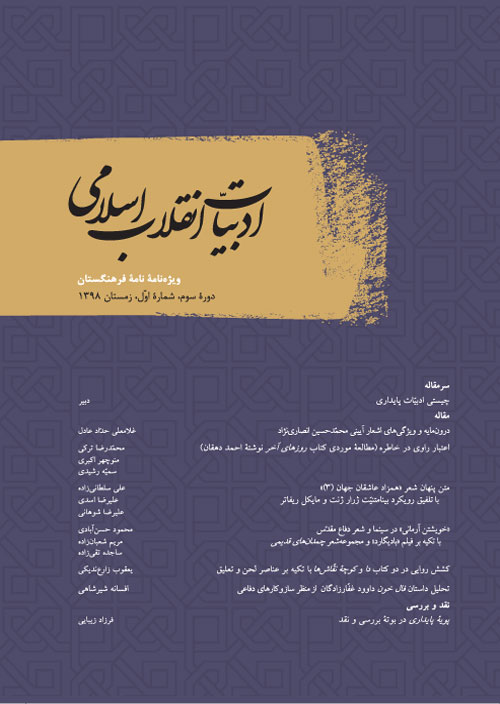فهرست مطالب

نامه فرهنگستان
سال هجدهم شماره 1 (پاییز و زمستان 1398)
- ادبیات انقلاب اسلامی (5)
- تاریخ انتشار: 1399/05/12
- تعداد عناوین: 8
-
- سرمقاله
-
صفحه 3
- مقاله
- نقد و بررسی
-
صفحه 184
-
Page 23
A flourishing trend emerging from the literature of the Islamic Revolution, ritualistic poetry, albeit with a history in Persian literature and rooted in religious poetry, has over the past decade attracted into the arena of contemporary literature young and lively figures less heard of in previous epochs of Persian literature. These figures are the embodiment of a genre of poetry that not only manifests a transcendental and spiritual content but also exhibits a flourishing novelty in form and structure unprecedented in contemporary times. Mohammad-Hossein Ansarinezhad is one such poet and the present article is devoted to an investigation of the themes and verbal qualities in his volume of ritualistic poems Shams ul-Sharaf.
Keywords: Ritualistic poetry, religious poetry, Mohammad-Hossein Ansarinezhad, Shams ul-Sharaf -
Page 41
In a general perspective, narratology viewpoints in the field of “story” (including novels, short stories and so on) is founded based on the narrative characteristics of the story. Therefore, for illustrating “Memory” as a narrative context with unique characteristics, we need to redefine a number of the descriptions according to fundamental ideas about narratology along with considering the special characteristics of memory. In this article, after a brief discussion about memory, its components, its narrative characteristics, the narrator’s role and James Phelan’s theory of the narrator’s reliability and we examine the role and reliability of the narrator in Ahmad Dehghan’s book Rouzha-ye Akhar based on the viewpoints of rhetorical narratology. Our main purpose is to identify the narrator’s role and his functions and to measure the reliability of his dialogue according to James Phelan’s “theory of unreliable narrator”. With this study, it is known that the narrator of the memory by using various methods such as omission, reticence, moral and ideological evaluations, repetition, etc to support his purposes and this can change him into an unreliable narrator in all three aspects of reporting, interpretation, and evaluation.
Keywords: Rhetorical narratology, memory, narrator, unreliable narrator, Rouzha-ye Akhar -
Page 67
The theory of intertextuality or hidden text is one of the contemporary literary theories that Julia Kristeva coined it in sixties of the 20th century. Many scholars were effective in formation of this theory, that among them the applicable approaches of Gérard Genette and Michael Riffaterre more correspond with Persian poetry. In this article, we will discuss the reading of Gheisar Aminpour’s poem titled “Hamzad-e Asheghan-e Jahan (3)” [Along World’s Lovers (3)] upon the intertextuality approaches of Genette and Riffaterre and its aim is accessing to the main concepts and close reading of this poem. Real reading of the mentioned poem requires hypertexts analysis and retrieval due to symbols and implicit signs. The question is that “Is there the possibility of the analysis of Aminpour’s poem and reflection of its hypertexts with intertextuality of Genette and Riffaterre?” For answering this question, first the most corresponding suggestions of Genette and Riffaterre with Persian Poetry was blended and described. Aminpour’s poem was analyzed based on Genette’s theory in the case of explicit, inexplicit and implicit hypertextuality and intertextuality genres and based on Riffaterre’s theory in the case of density, polysemy, descriptive system, hypogramme and matrice, and the hidden text of this poem and its intertextuality relations with the poem of Hafez and Sayeh were revealed. A new reading of Aminpours poem has been presented through the analysis of his poem and revealing its hidden texts.
Keywords: Hidden Text, Intertextuality, Gheisar Aminpour, Gerard Genette, michael Riffaterre -
Page 155
Since war creates the most severe forms of fear, anxiety, and frustration in individuals, it is desirable that such components be reflected in the effects of war and sacred defense. Davoud Ghaffarzadegan's story Fal-e Khoun is written in the context of the events of the imposed war and the psychological pressures and its consequences, namely coercion, displacement, violence, death, etc, and it can be examined from a psychological point of view. In this article, the descriptive-analytical method examines the story from Freud's point of view of personality theory and the fear, anxiety, and disorders that result from it, and the defense mechanisms against such situations. Based on the findings of this study, the characters of the story, in order to reduce the psychological damage caused by fear and anxiety of war, use defense mechanisms such as displacement, simulation, repression and retaliation, sublimation, projection and dispersal reason. Drugs, repression of memories, obscenity and humiliation of each other, violence and fantasy, and the torment of conscience are manifested.
Keywords: Fal-e Khoun, Davoud Ghaffarzadegan, psychological criticism, Defense Mechanism

